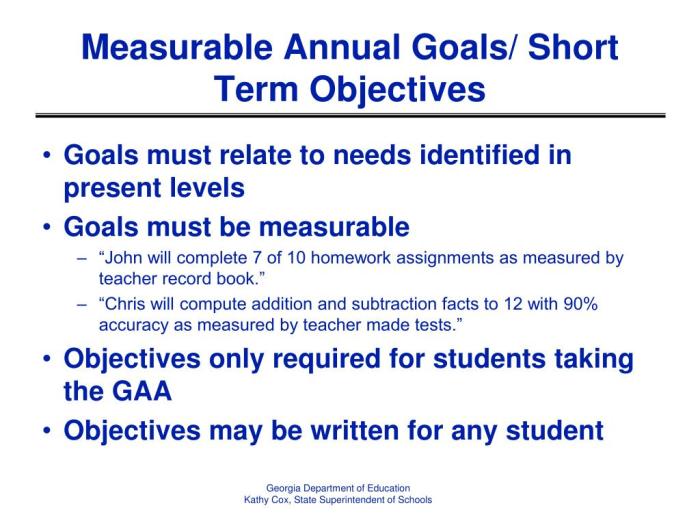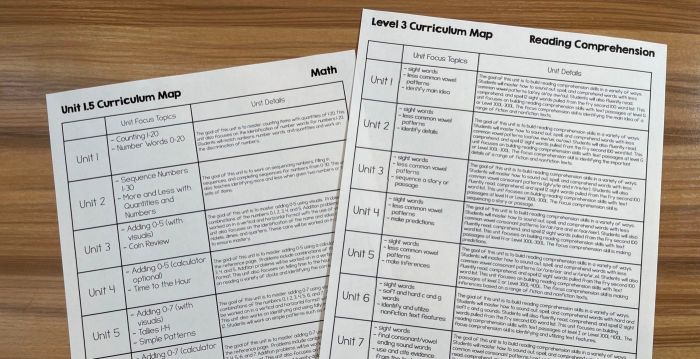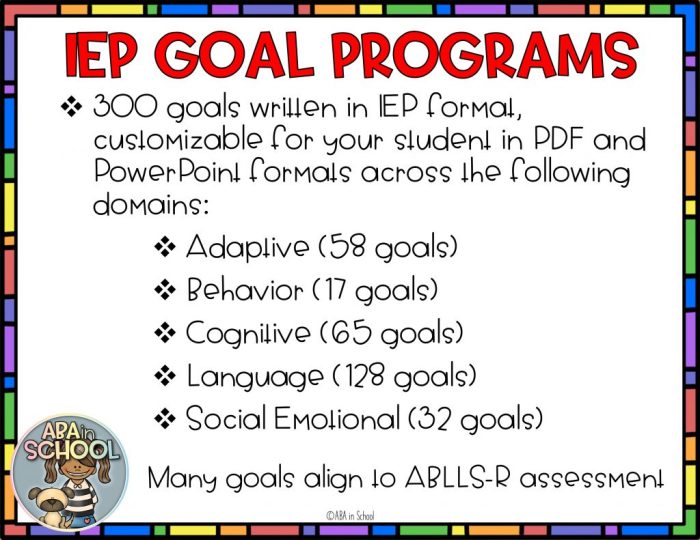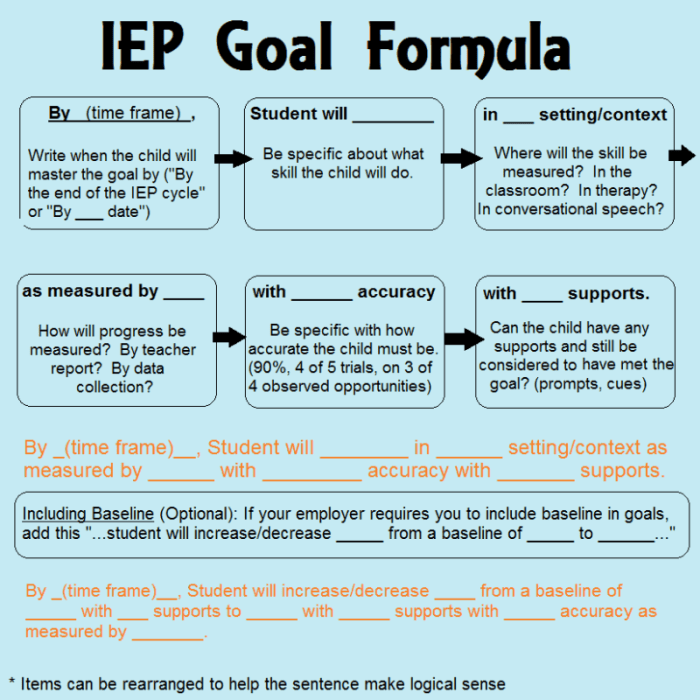Short term objectives for iep – Short-term objectives for IEP play a crucial role in shaping the educational journey of students with disabilities. This guide delves into the intricacies of crafting effective short-term objectives, empowering educators and parents to create tailored plans that drive progress and success.
Defining short-term objectives, understanding their purpose, and mastering the components of a well-written objective are essential foundations for developing a robust IEP. This comprehensive guide navigates these aspects, providing step-by-step guidance and practical strategies to ensure that short-term objectives are achievable, measurable, and aligned with individual student needs.
Short-Term Objectives for IEP

Short-term objectives for IEP are specific, measurable, attainable, relevant, and time-bound goals that are developed for a student with a disability as part of their Individualized Education Program (IEP). These objectives are designed to help the student make progress towards their annual goals and improve their educational outcomes.
Purpose of Short-Term Objectives in IEP
The purpose of short-term objectives in IEP is to:
- Break down long-term goals into smaller, more manageable steps.
- Provide specific targets for students to work towards.
- Measure student progress and make adjustments to the IEP as needed.
- Help students stay on track and make progress towards their annual goals.
Components of a Well-Written Short-Term Objective
A well-written short-term objective should be:
- Specific:It should clearly state what the student is expected to achieve.
- Measurable:It should be possible to measure the student’s progress towards the objective.
- Attainable:It should be challenging but achievable for the student.
- Relevant:It should be related to the student’s annual goals and needs.
- Time-bound:It should have a specific timeframe for completion.
Developing Short-Term Objectives

Developing short-term objectives is a crucial step in creating an effective IEP. These objectives provide specific, measurable targets that guide instruction and track student progress. Here’s a step-by-step process to help you develop achievable and measurable short-term objectives:
Step 1: Identify Present Levels of Performance (PLP)
Gather data on the student’s current skills, abilities, and needs. This information will provide a baseline against which to measure progress.
Step 2: Establish Long-Term Goals
Define the desired outcomes for the student within a specific timeframe. These goals should be aligned with the student’s IEP and be specific, measurable, attainable, relevant, and time-bound (SMART).
Step 3: Break Down Goals into Objectives
Decompose long-term goals into smaller, more manageable steps. These objectives should be specific, observable, and measurable.
Step 4: Set Performance Criteria, Short term objectives for iep
Establish clear criteria for measuring student progress towards each objective. This could include specific levels of accuracy, completion rates, or observable behaviors.
Step 5: Monitor and Adjust
Regularly track student progress and make adjustments to objectives as needed. This ensures that objectives remain relevant and challenging, and that instruction is tailored to the student’s individual needs.
In setting short-term objectives for IEPs, it’s important to consider the impact of external factors like current events. For instance, the recent AJ hit in Texas highlights the need for increased focus on safety and preparedness. Incorporating these considerations into IEP objectives ensures that students are equipped to navigate the challenges they may encounter outside the classroom.
Types of Short-Term Objectives: Short Term Objectives For Iep

Short-term objectives are tailored to the specific needs of each student, considering their individual strengths, challenges, and goals. These objectives can be categorized into three primary types: academic, behavioral, and social.
Academic objectivesfocus on improving the student’s academic skills and knowledge. These objectives can include goals such as increasing reading fluency, improving math problem-solving abilities, or enhancing science vocabulary.
Behavioral Objectives
Behavioral objectivesaim to address specific behaviors that impact the student’s learning or social interactions. These objectives may involve reducing disruptive behaviors, promoting positive social interactions, or developing self-management skills.
Social Objectives
Social objectivestarget the student’s ability to interact with others in a positive and productive manner. These objectives can include goals such as improving communication skills, developing friendships, or fostering cooperation with peers.
Monitoring and Evaluating Short-Term Objectives

Monitoring and evaluating student progress towards short-term objectives are crucial to ensure their effectiveness and alignment with the overall IEP goals. This process involves collecting and analyzing data, making adjustments as needed, and ensuring that the objectives remain relevant and attainable.
Methods for Monitoring Student Progress
- Direct Observation:Observing students during activities or tasks related to the objectives can provide valuable insights into their progress.
- Work Samples:Collecting student work samples, such as assignments, quizzes, or projects, allows for ongoing assessment of their understanding and skill development.
- Student Self-Assessment:Engaging students in self-assessment encourages reflection and provides valuable feedback on their progress towards objectives.
- Teacher Feedback:Regular feedback from teachers can help identify areas where students are excelling or struggling, guiding adjustments to objectives.
Data Collection and Analysis
Data collected through monitoring methods should be analyzed to assess objective effectiveness. This may involve:
- Trend Analysis:Tracking student progress over time can identify patterns and areas for improvement.
- Performance Comparisons:Comparing student performance to benchmarks or peers can provide insights into their strengths and weaknesses.
- Error Analysis:Examining errors in student work can reveal misconceptions or areas requiring additional support.
Revising and Adjusting Objectives
Based on evaluation results, short-term objectives may need to be revised or adjusted to ensure they remain appropriate and effective. This may involve:
- Modifying Objectives:Objectives may be adjusted to make them more specific, measurable, attainable, relevant, and time-bound.
- Adding or Removing Objectives:New objectives may be added to address emerging needs, while ineffective objectives may be removed.
- Changing the Timeline:Objectives may be extended or shortened based on student progress and the need for additional support or challenge.
FAQ Compilation
What are short-term objectives for IEP?
Short-term objectives are specific, measurable, and achievable goals that guide student progress within a specific time frame, typically a grading period or semester.
Why are short-term objectives important in IEP?
Short-term objectives provide a roadmap for student progress, ensuring that instruction is targeted and aligned with individual needs.
What are the components of a well-written short-term objective?
A well-written short-term objective includes a description of the desired behavior, the conditions under which the behavior will occur, and a measurable criterion for success.

